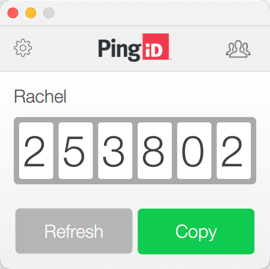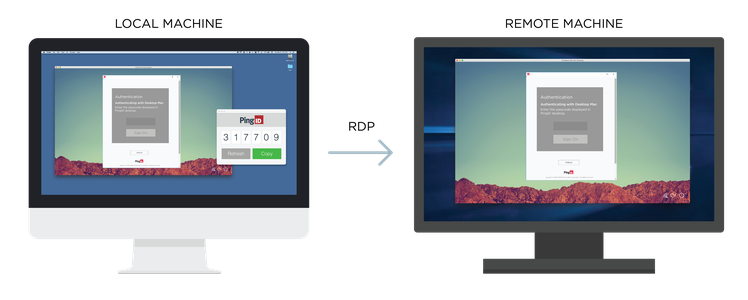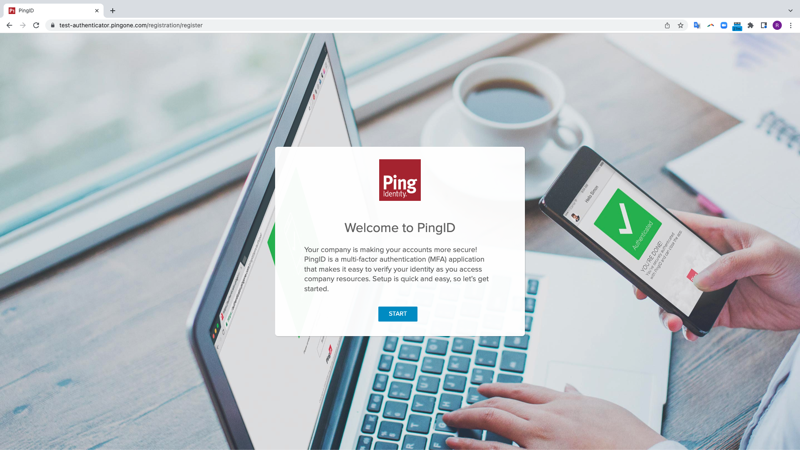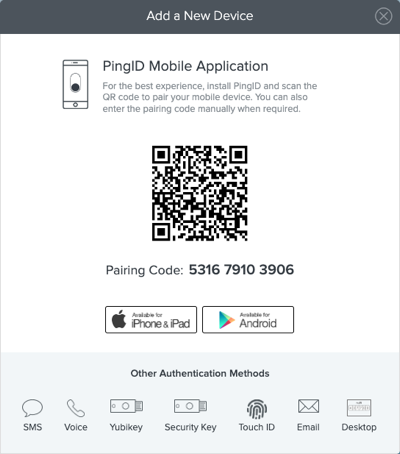Using PingID desktop app authentication
Use PingID desktop app to authenticate using an app on your computer (PC or Mac) for a secure sign-on experience.
To set up PingID desktop app authentication, you need to download PingID desktop app to your computer, and then register or 'pair' it with your account. Pairing creates a trust between the desktop app and your account so that you can use the app to authenticate.
After pairing your device with your account, each time you sign on to your account, launch the PingID desktop app to generate a one-time passcode (OTP) you can use to authenticate.
After you have paired your device and authenticated successfully, you can use the app to authenticate when accessing your account using a web browser, to access your company VPN, or to access a Windows login machine using Remote Desktop Protocol (RDP), if your company configuration allows it.

You can find information on managing your PingID desktop app, including software updates, changing your PIN, adding an organization, and sending log in PingID desktop app management.
|
The option to pair your account with this device type is defined by your company policy. |
PingID desktop app for remote access for Windows login
If you want to use PingID desktop app for remote access for Windows login, you need to download and install the PingID desktop app to a different laptop or desktop from the one that you are trying to access remotely and pair (connect) that machine with your account. Then, you can receive a one-time passcode (OTP) from the local PingID desktop app to authenticate and sign on to your Windows machine remotely using RDP.

-
Pair desktop app
-
Install on Mac
-
Install on Windows
Pairing your PingID desktop app
To set up PingID desktop app for secure authentication, you need to register or 'pair' PingID desktop app with your account.
Before you begin
-
Install the PingID desktop app. This is often done by your administrator. For instructions on how to install it yourself, see the relevant tab in this section for Mac or Windows.
About this task
After you have paired your device and authenticated successfully, you can also use the app to authenticate when accessing your VPN, or a Windows login machine using Remote Desktop Protocol (RDP), if required.
|
If you already have a device paired with your account and your organization allows you to pair more than one device, you can add the PingID desktop app as an authentication method in the My Devices page. For more information, see Adding and reordering devices. |
Steps
-
Sign on to your account or app and when you see the registration window, click Start.

You’ll see the Add a New Device window, showing the QR code.

-
In the Add a New Device window, click Desktop.
Result:
The Desktop Setup window opens, displaying a Pairing Key.

-
Launch the PingID desktop application, and in the Pairing Key field enter the pairing key from step 2 and then click Pair.

-
(Optional) If you want to create a user profile, before you enter the pairing key, click
 , enter a name for the profile, and then click Create. The Desktop app shows the name of the profile and the Pairing Key field.
, enter a name for the profile, and then click Create. The Desktop app shows the name of the profile and the Pairing Key field.Result:
A one-time passcode (OTP) generates. If you are prompted to create a PIN code, see step 4.
-
If your organization requires you to create a PIN code:
-
In the Enter PIN field, enter a PIN code. Click Next.

The PIN code must be either 4 or 6 digits, as specified, and include more than 2 different digits if the PIN length is 4 digits, or 3 different digits if the PIN length is 6 digits. Digits must not be in ascending or descending sequence. For example, 1111, 123321, 8787, and 765432 are not allowed.
-
Re-enter the PIN code when prompted. Click Done.
Result:
An OTP is generated.

-
-
The next time you sign on to your account or app using a web browser, use the PingID desktop app to authenticate:
-
Launch the PingID desktop app to generate an OTP.
-
Copy the OTP.
-
Paste the OTP into the Authentication field in your browser.
-
Click Sign On.

Result:
The green checkmark appears indicating your successful authentication. Your browser redirects to the portal or app you need to access.
-
Related links
Installing PingID desktop authentication on a Mac
Install desktop authentication on your Apple Mac machine so that you can pair it for secure authentication.
Before you begin
-
Ensure you have administrator privileges on your machine
About this task
To start using PingID desktop app, you need to:
-
Download and install PingID desktop app.
-
Pair PingID desktop app with your account.
After you have installed and paired your device, you can use PingID desktop app to authenticate when access your account using a web browser, your VPN, or your Windows login machine using RDP.
Steps
-
Download PingID desktop app for Mac, and click Save.

-
Install the PingID desktop app:
-
To launch the PingID desktop app installer, click the
PingID.pkgdownload file. Click Continue.
-
Review the Software License Agreement and click Continue. Click Agree.


-
In the Select a Destination window, in the Destination Select section, select the disk where you want to install PingID for Desktop. Click Continue.

-
To change the location where PingID is installed, in the Installation Type section, click Change Install Location and browse to the new location.

-
Click Install.
By default, the PingID desktop app installs in the Applications folder.
-
If prompted, enter your system password.
Result:
The PingID desktop app installer window displays the The installation was successful message with a green check mark. PingID is added to the Applications list on your Mac.

-
Click Close.
-
Next steps
Pair PingID desktop app with your account. For information, see Pairing your PingID desktop app.
Installing PingID desktop authentication on Windows
Install the PingID desktop app on your Windows machine so that you can pair it for secure authentication.
About this task
To start using PingID desktop app on your Windows machine, you need to:
-
Download and install PingID desktop app.
-
Pair PingID desktop app with your account.
After you have installed and paired your device, you can use PingID desktop app to authenticate when access your account using a web browser, your VPN, or a different Windows login machine remotely, using RDP.
Steps
-
Download PingID desktop app for Windows, and click Save.
-
To install the PingID desktop app:
-
Click the
pingID.exedownload file to launch the PingID desktop app installer. -
In the Select install mode window, choose the relevant option:
-
Install for me only: install the desktop app on your local machine.
-
Install for all users: For administrators only. Allows administrators to install the desktop app on multiple machines concurrently.

Result:
The PingID Setup wizard opens.
-
-
Review the Software License Agreement and select I accept the agreement. Click Next.

Result:
The License Agreement window opens.
-
Click Browse and select the folder in which you want to install PingID and then click Next.

Result:
The Configure PingID window opens.
-
To synchronize the settings in the domain roaming folder, select the Support Roaming User Profiles check box.

During a manual update or reinstall over an existing installation, the ConfigurePingIDEnable optional features window does not display. The previous installation setup is maintained.
-
To add the Support Roaming User Profiles setting to an existing configuration when it was not previously enabled:
-
Unpair your Windows desktop app.
-
Uninstall the desktop app, reinstall, and select the Support Roaming User Profiles check box to allow the use of roaming user profiles.
-
-
Click Next.
Result:
The files are extracted and the PingID desktop app launches.
-
Next steps
Pair PingID desktop app with your account. For information, see Pairing your PingID desktop app.